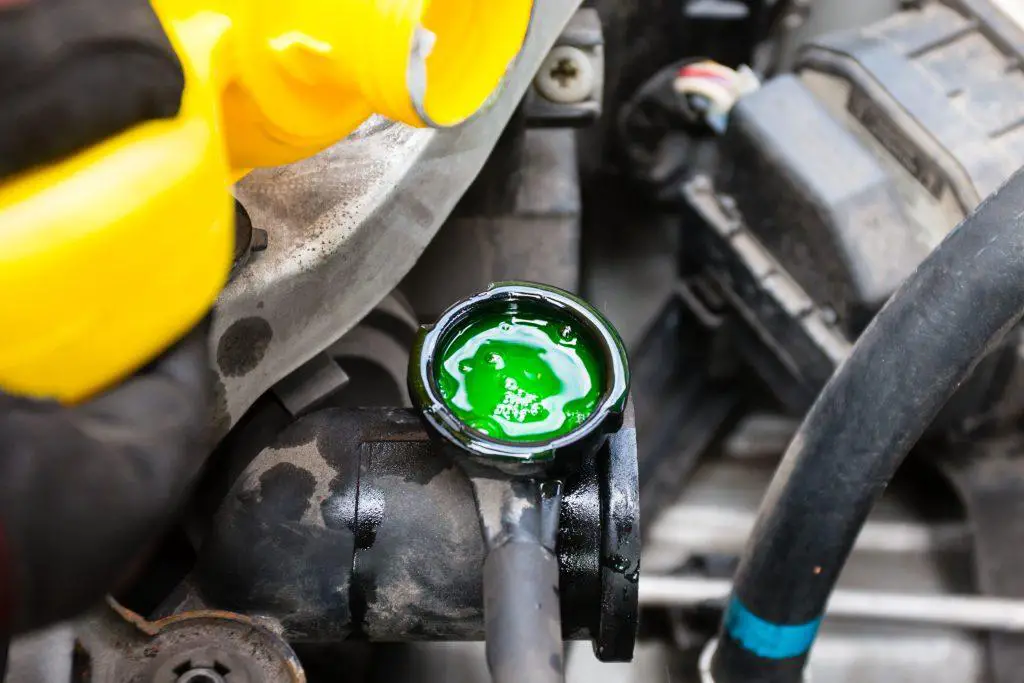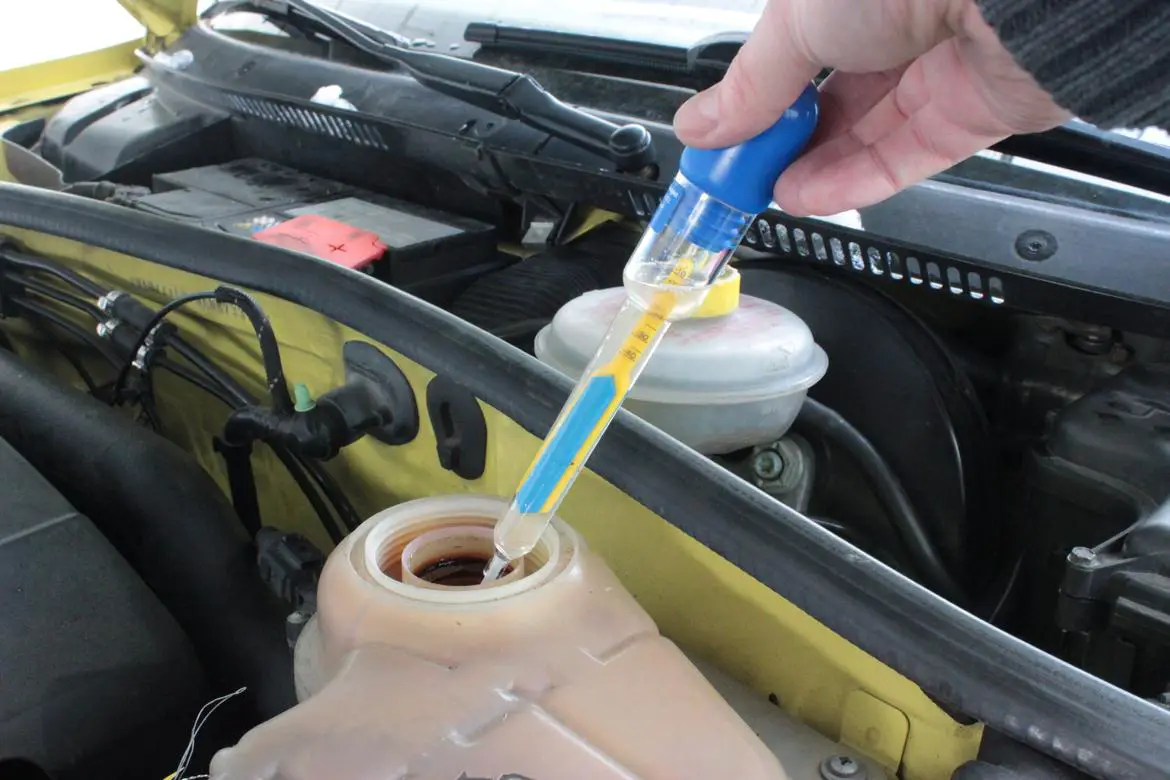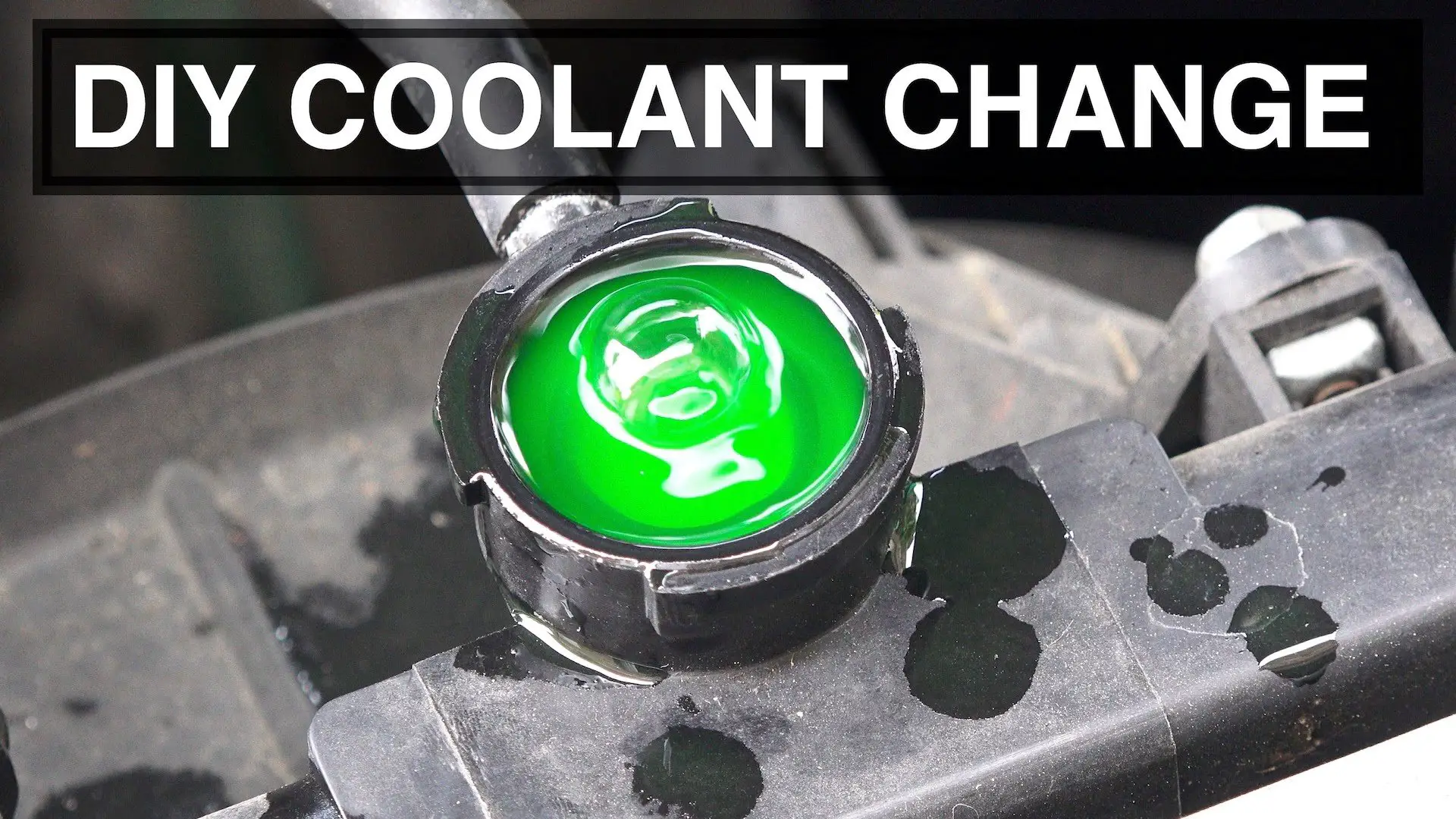Is A : 50 Engine Coolant Mixture Necessary When Refilling Your Coolant Reservoir
For this query, I will answer by way of comparison. If only pure water were used as a coolant, it would immediately freeze the moment the temperature falls below 32 °F, not being able to circulate through the engine as a result. Similarly, the coolant would crystallize at 0 °F if only pure antifreeze were used.
Pure antifreeze does not have enough heat capacity, lowering the heat-transfer capabilities of your vehicles cooling system by an average of 35% . When not mixed with water, it loses its protective properties and can make the engine more prone to overheating and its parts susceptible to corrosion.
That said, using a 50:50 antifreeze-water mixture is indeed necessary when replenishing your coolant levels. Water mixed with antifreeze lowers the coolants freezing point to approximately -35 °F. Furthermore, it keeps performance additives like silicates and phosphates suspended in the mixture, not settling to the bottom of the cooling system and causing a whole range of problems.
Distilled water versus tap water is always best to use when creating your coolant mixture, as the former does not contain minerals that can form deposits in your vehicles cooling system passages and radiator. In dire circumstances where you have an overheated engine and adding pure water to your radiator will help get you home, putting water in your car instead of coolant is permitted. However, refrain from doing this repeatedly or for longer than necessary.
What Happens If You Dont Change Your Engine Coolant
If you dont change the engine coolant every 30,000, its probably not going to be the end of the world. That being said, failing to properly service the coolant system can result in overheating, which could lead to severe engine damage such as a blown head gasket.
The engine coolant is what prevents your engine from overheating, so you definitely dont want to forget about this service. The average cost to change engine coolant at the shop is estimated to be between $98-$123. However, this is an easy job for beginner DIYers, and those willing to undertake this service should expect the job to take less than an hour to complete. Plus, doing this yourself could save upwards of $100 in labor costs!
Why Is Engine Coolant So Important
Without the coolant, the heat produced during constant internal combustion would ruin the engine very quickly. Although coolant is mixed with water, the water alone isnt able to keep the engine cool. The heat of the engine would eventually start boiling the water, or the summer heat would evaporate it.
Recommended Reading: Are Grandchildren Eligible For Usaa
Why Does The Colour Of Engine Coolant Matter
Colour is a good indication of your engine coolants condition. The coolant should be the same colour as when you first put it in any change towards a rusty, reddish-brown hue signals replacement.
We advise you to check the level and colour of your cars engine coolant periodically at least once a week so that any problems can be dealt with before they get out of hand.
Recommended Brand Of Antifreeze

Check what brand and type of antifreeze your cars manufacturer recommends for you to use.
Those of you with antique cars or cars with particular needs might want to call your mechanic in the first instance, just to be extra sure.
Theres a chance they took the decision to use a different brand thats more fitting, for a number of different reasons. If thats the case, it might be best to skip the manufacturers suggestion. .
Read Also: How To Fix Burn Holes In Car
Top 3 Issues That Occur When You Need A Coolant Flush
The summer heat presents unique challenges to vehicles in the south. Thankfully, your vehicle has measures in place to keep your engine protected. This important task is largely placed on your engines cooling system and the antifreeze that keeps it running. It is essential to keep this coolant fresh with manufacturer-recommended coolant flushes. So how do you know if you need a coolant flush? Here are the top signs of this needed service, brought to you by the mechanics at Chapel Hill Tire.
Why Should You Change Your Engine Coolant
Unsurprisingly, the effectiveness of the coolant fluid in your cars engine deteriorates over time: the antifreeze chemicals lose their strength, especially if you top them up with water regularly. And in harsh winter weather, this can lead to the coolant freezing and expanding which will damage the engines components.
For that reason, the cooling system should be drained, flushed and refilled every so often to replenish the antifreeze mixture and prevent rust and corrosion from forming.
Read Also: How To Keep Car Doors From Freezing
Remove The Lower Hose
Draining and Refilling Coolant in Newer CarsChanging your coolant yourself, including buying the air-powered refill tool, will save about $50 on your very first coolant change, and about $100 on each one after that. This procedure works for any cooling system thats not contaminated with rust or oil. Well show you how to check yours and then how to change the coolant.
Heres what youll need: New coolant Air-powered refill tool Air compressor Hose removal tool Shop manual to locate block drain plugs Drain pan Absorbent paper towels Wrenches and screwdrivers
Start by checking the condition of your coolant when the engine is cool. Remove the radiator or coolant reservoir cap and examine the coolant color. If it looks rusty , has crud or oil floating on the top, or looks like chocolate milk, call it quits and take it to a pro. You have problems that this procedure wont solve.
If the coolant looks clean, start the job by jacking up the vehicle and supporting it with jack stands. Next, place a large drain pan under the radiator. Loosen the lower radiator hose clamp with pliers or screwdriver and remove the hose. If the hose wont budge, use a hose removal tool to break it loose . Let the radiator and water pump drain completely. Then reattach the lower radiator hose and clamp.
Next, locate and remove the block drain plugs . Reinstall the block drain plugs and move on to the refilling step.
How To Check Coolant In Your Car
Steps to check the coolant in your car are in step #6 of this guide. However, there is more to it than just inspecting coolant levels. The appearance of the engine coolant is also important, as it will indicate if following the usual 10-step process is enough or doing a drain or radiator flush is needed.
Engine coolant is usually red, green, blue, or yellow, each color having its corresponding use. Ford sets a perfect example by offering color-coded engine coolant for specific model years of its vehicles.
Tier systems may not apply to all vehicle manufacturers. Hence, visual inspection of the engine coolant seems to be a more reliable method. If the fluid is colorless, looks rusty, or has particles floating in it, flushing your cooling system is required. These signs signify corrosion of internal components resulting from a long-overdue coolant change. Moreover, they are an indication that the radiator has been filled with mixed types of coolant in the past.
Conversely, if the coolant appears to have a sludgy or oily surface, professional servicing by a mechanic is a must. In this specific situation, the culprit is most likely an internal head gasket leakage and only professional mechanics have the appropriate equipment to conduct the needed checks.
You May Like: How To Notarize A Car Title In Az
The Stuff Of Engine Coolant
Nearly all engine coolants are based on water, an excellent heat transfer medium. Ethylene glycol or propylene glycol make up much of the rest of the mixture, preventing freezing, but you cant just dump water into your engine if you live in an area that never gets cold. Additives give engine coolant a much longer life than plain water. Corrosion inhibitors, lubricants, anti-foaming agents, colorants and other additives keep the water/alcohol blend from eating your engine.
Additive life essentially determines engine coolant lifespan in any given engine, whatever or wherever you drive. Exposure to heat and oxygen breaks down the additives, leading to the formation of deposits and allowing corrosion to damage your engine from the inside out.
Why Is Coolant Replacement So Important
Changing the coolant is a basic activity for every occasional driver. This affects the proper operation of the entire vehicle. Especially a hot engine when traveling long distances. Failure to change the fluid in the car leads to various malfunctions.
Cracked head gaskets or damaged blocks are the most common ailments in cars where the coolant is not replaced. The fluid loses its properties over time and needs to be replaced to keep the engine at a constant temperature.
Don’t Miss: Car Freshie Recipe
It Never Pays For Neglect Coolant Changes
A leaking heater core can requires the removal of the entire dash board. While the heater core itself is fairly cheap, around $100, the labor will cost you at least $1,000. A leaking radiator costs around $400 and the labor is around $150-$300. But thats not the worst case scenario. Worst case is that your radiator leaks, you run low on coolant and your engine overheats causing a head gasket failure. Now youre looking at a $2,000 repair. A leaking water pump can cost between $300 and $1,200.
Sweet Maple Syrup Car Smell

One distinct sign of a needed coolant flush is an engine smell that may remind you of pancakes. Antifreeze contains ethylene glycol, which is known for its sweet-smelling properties. As your car burns through coolant, it can put off smells that drivers often compare to maple syrup or butterscotch. While the smell may be nice, it is a sign that your engine needs attention as it burns through your antifreeze.
Read Also: Who Invented Golf Carts
How To Check Engine Coolant
Most new cars have a dashboard warning light which lights up permanently if there is a problem with your engine cooling system. It is important not to ignore this warning, as doing so can result in further damage to your car. Instead, get your vehicle booked into your local garage as soon as possible to get the engine coolant checked. For more information read our post about what you should do if your engine coolant warning light comes on.
Regardless of whether your car has a warning light or not, you can also check your engine coolant level manually:
Steps to check your engine coolant
If you notice that your engine coolant level is low, you should take it to a garage to get checked. Most modern cars come with a sealed cooling system, so shouldnt need topping up unless there is a problem.
Warning Signs For Coolant Change
We have seen how you should change your coolant in regular intervals for longer lives of your cars. Sometimes along with coolant change, your personal transport itself needs some parts change. We also deal in auto spare parts, checkout our . So now, lets look at some of the warning signs given by your car to change the coolant. Usually the vehicle manual has such information on how often the coolant needs to be changed.
One of the major signs is when your car starts heating up unnaturally. So, when your car starts overheating, it is a sign that maybe your coolant is contaminated and you need to change it.
You May Like: Hail Protection Blanket
Engine Coolant Light On
The engine coolant symbol shows the cars radiator with the cap at the bottom, and waves below. This warning light is particularly important and should be taken seriously. These are the reasons why the engine coolant light can turn on:
- The engine coolant temperature is too high: this means that your engine is overheating.
- The engine coolant level is too low. This is probably because the engine coolant is leaking.
- The engine coolant temperature sensor is failing and needs to be replaced.
The first thing to do is safely stop your car as soon as possible, and let the engine cool down. We recommend that you call your assistance, and have a mechanic check the engine cooling system.
How Often Does Antifreeze Need To Be Changed
It is recommended to change the engine coolant/antifreeze in your car after 60,000 miles, or every 2-4 years. However, as soon as a mechanic accesses your car cooling system, it is recommended to change it there and then. You should check the engine coolant level on a regular basis: if you do so, you can notice an engine coolant leak if the level is too low.
It is important to change the engine coolant when needed, as without coolant to regulate the engine temperature, some parts such as the head gasket could break, and this kind of repair has a very high cost.
Read Also: Car Making Scraping Noise When Accelerating
How Often Should I Put Coolant In My Car
Top it up periodically or every time coolant levels are not up to spec to avoid overheating the engine. When doing a full coolant flush and replacing it, the timing is different. While some car owners rarely change their engine coolant, most experts recommend doing so every 30,000 to 70,000 miles.
Other vehicles may even take longer than 70,000 miles before needing a coolant flush/change. Some institutions, like Prestone UK, suggest checking your engine coolant/antifreeze at least every two weeks. But again, coolant change intervals depend on the amount of driving you do and the weather.
Cooling System Flush Cost
Many shops advertise a radiator flush for around $100. But a radiator flush isnt the same thing as a cooling system flush. Its exactly what it says, a radiator flush that ignores the worn out coolant still left in the engine block. So you really want a cooling system flush. That requires special equipment and the installation of the factory specified coolant. So a real cooling system flush costs around $200. $200 is a small price to pay to avoid a leaking heater core, radiator or water pump.
Read Also: Places That Accept Car Care One Credit Card
Check The Liquid Level How Much Coolant Should There Be
The operating fluid level can be easily checked. Manufacturers place spoons on packages that specify minimums and maximums. How much coolant should be in the tank? Refer to the vehicle manual for recommended fluid levels. You should never add liquid when the engine is hot, as this can cause serious damage to the cooling system. Only check the condition of the fluid when the engine is off and cold.
One: Drain The Existing Coolant

First you need to drain the old coolant from three important places, radiator, engine and the coolant reservoir.
- Before you being to drain coolant, remove the radiator plug. You might want to rest the cap on top to avoid any kind of contaminants falling into the radiator.
- To actually start draining the coolant, put any kind of pot or container under the radiator and loosen the drain plug. This will flush out all the coolant thats there in the radiator.
- After all of the coolant is drained, its time to flush out the engine of any coolant. Put your container under the engine. Remove the engine drain plug to flush out the engine and the heater core of any coolant.
- Now, put the engine drain plug back and tighten it. Do the same with the radiator drain plug. It will be good idea at this point, to use a good sealant before tightening these plugs to avoid any kind of leakage.
- Now come to the Coolant Reservoir. Drain it of any and all coolant in it. Clean it up properly and put it back.
You May Like: How To Transfer A Car Title In Az
Should The Car Be Cold To Add Coolant
It is better to wait until your cars engine is cold or have sat for at least three hours. But in typical situations, the engine should be cool before adding coolant to the radiator. Never attempt to add coolant to the radiator if the engine temperature is hot, as there is a big chance pressurized water can escape from the reservoir when you unscrew the coolant cap. The hot, pressurized water can very likely scald your skin.
Do I Need To Flush My Cars Cooling System
In a word, probably. Over time, inferior quality coolant/antifreeze can pick up particles from around the engine, causing corrosion which can lead to leaks and other expensive repair jobs. Removing these deposits and restoring the corrosion protection is vital to a safe and fully-functioning cooling system, especially if you want to avoid unexpected breakdowns brought on by overheating, leaks or engine failure.
Read Also: How To Clean Plastic Car Door Panels
Can I Use Just Water As Coolant
The short answer is yes, you can, but it shouldn’t be a habit and only be used in emergencies. There is a reason for having a ratio of 50/50 coolant to water in your cooling system. This is because water only won’t be able to do the job, and it’s expected to evaporate at certain high temperatures and freeze at certain low temperatures. Therefore, the coolant should not be only water because it’s a combination of water, anti-freeze, and some additives to get the job done properly.
